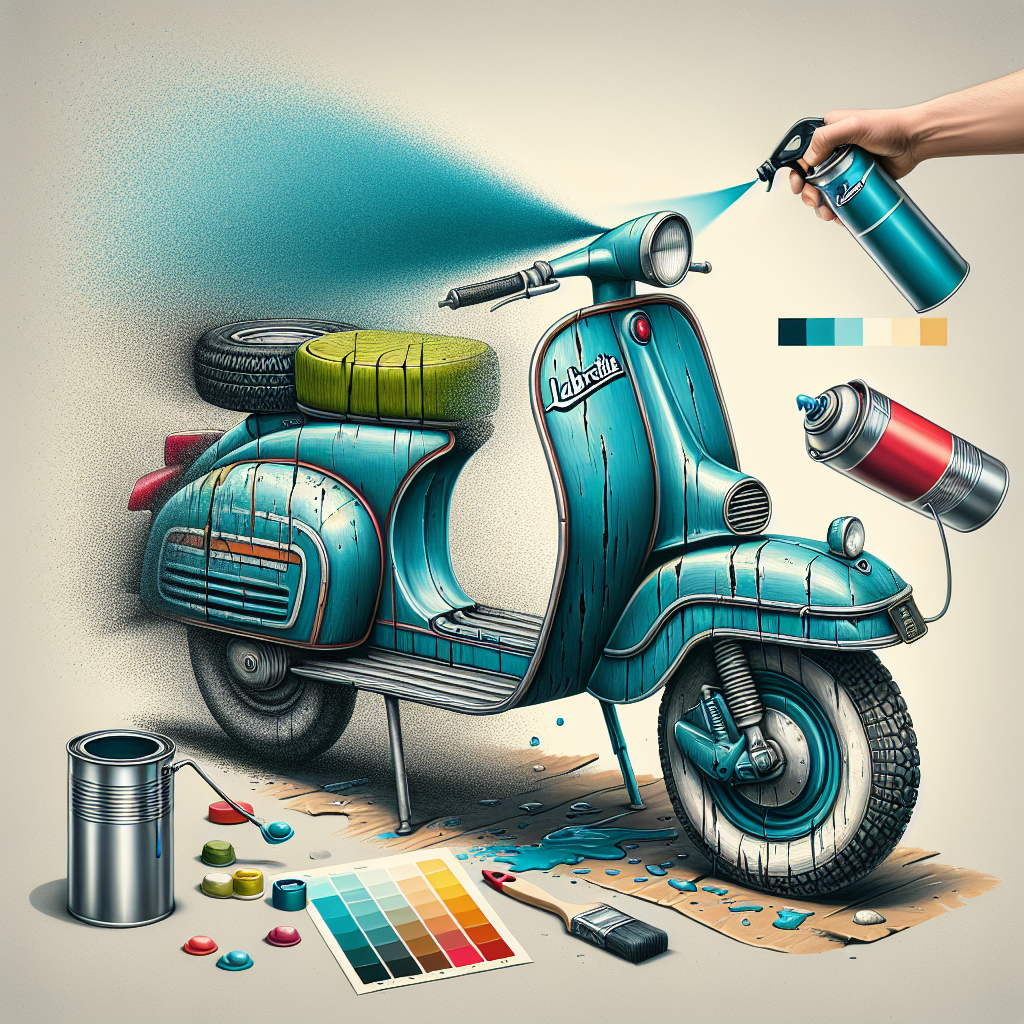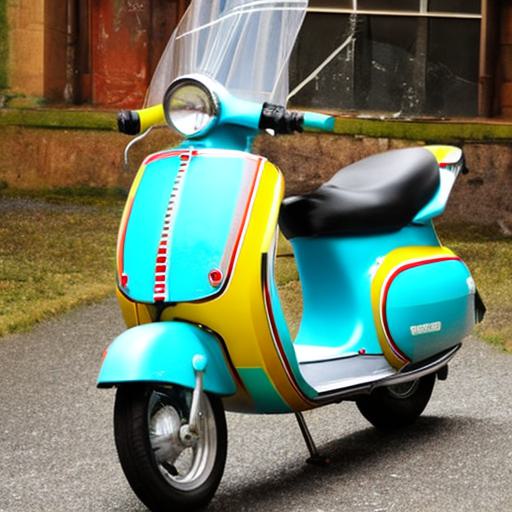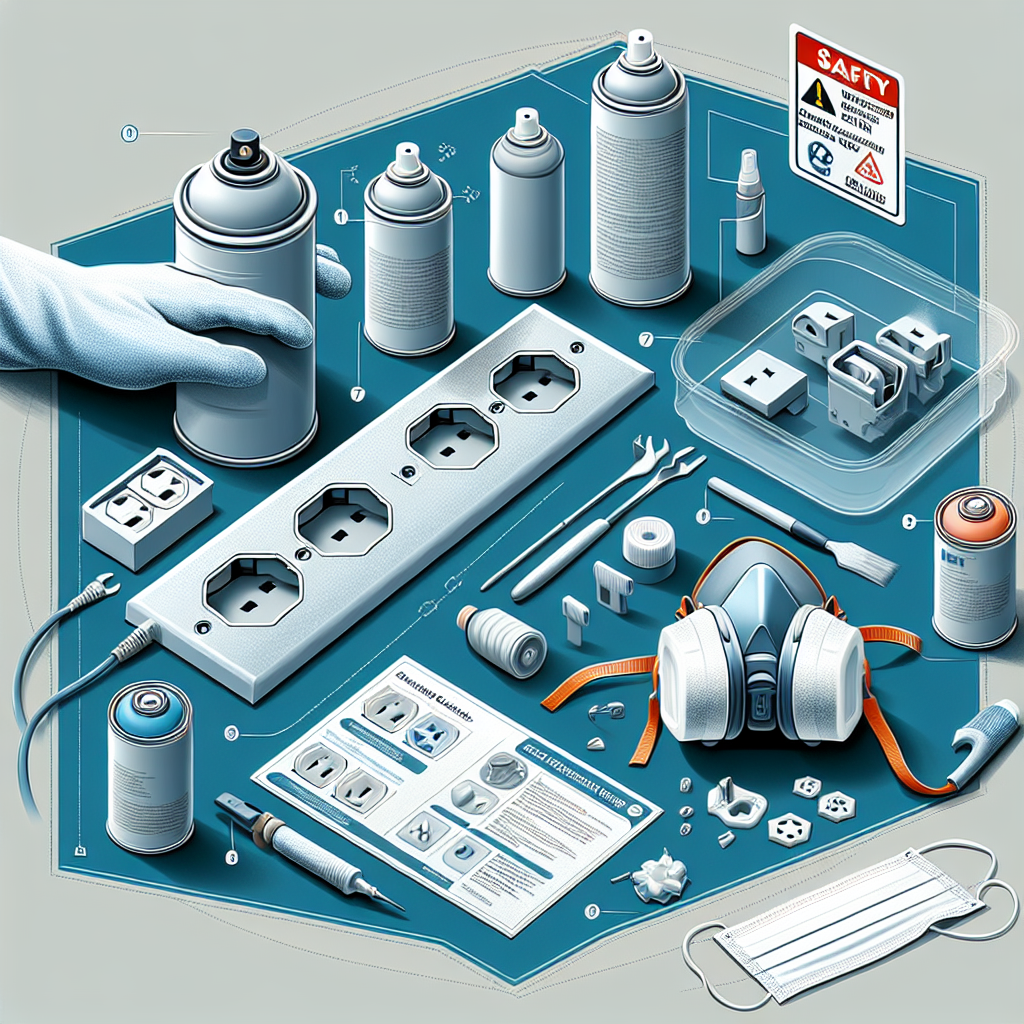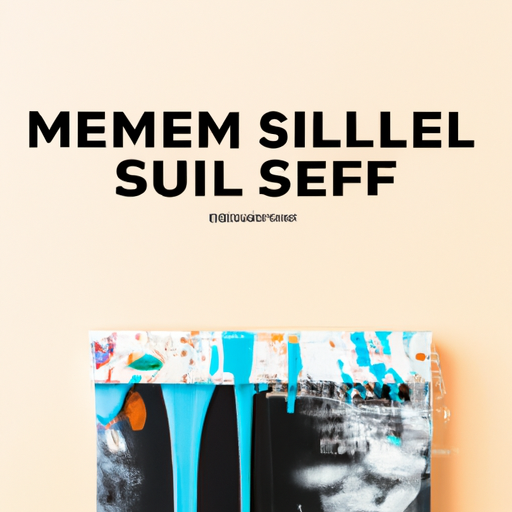Determining the exact amount of paint needed to spray a Lambretta scooter can be a critical factor in achieving a flawless and professional finish. In this article, you will gain a comprehensive understanding of the factors that influence the quantity of paint required for the task at hand.
By exploring the size of the Lambretta, type of paint, preparation techniques, and expert tips, you will be equipped with the necessary knowledge to confidently calculate the ideal amount of paint needed for your Lambretta project.

This image is property of images.unsplash.com.
Understanding the Painting Process
As a Lambretta owner, understanding the painting process is essential to ensure a professional and long-lasting finish for your beloved scooter. Whether you’re a seasoned DIY enthusiast or a beginner, having a solid grasp of the basics will help you achieve outstanding results. This article will guide you through the various steps involved in painting a Lambretta, common mistakes to avoid, and provide valuable tips for a flawless finish.
Basics of Vehicle Painting
Before diving into the specifics of painting a Lambretta, it’s important to understand the basics of vehicle painting. Vehicle painting involves a multi-step process that includes surface preparation, applying primer, base coat, and protective clear coat. Each step is essential for achieving a smooth, durable finish. Proper paint application techniques, such as using an appropriate spray gun and maintaining the right distance from the surface, play a critical role in achieving professional results.
Steps in the Painting Process
The painting process for a Lambretta typically involves several key steps. Firstly, thorough surface preparation is crucial to ensure proper adhesion of the paint. This includes cleaning the scooter’s surface, removing any rust or debris, and sanding it down to create a smooth base. Next, applying a suitable primer helps improve paint adhesion and enhances the overall durability of the finish. Once the primer has fully cured, it’s time to apply the base coat, which determines the color of your Lambretta. Lastly, a clear coat is typically added to provide an extra layer of protection and to give the paintwork a glossy finish.
Common Mistakes in Spray Painting
While spray painting a Lambretta can yield exceptional results, there are several common mistakes that inexperienced painters often make. One of the most common errors is not properly cleaning and preparing the surface before painting. Neglecting this step can lead to poor adhesion and premature paint failure. Another mistake is not using the appropriate spray gun or not maintaining the correct distance from the surface, which can result in uneven paint application and overspray. Additionally, rushing through the painting process without allowing sufficient drying time between coats can lead to undesirable outcomes. By being aware of these mistakes, you can ensure a smoother painting experience and a superior finish for your Lambretta.
The Role of Your Lambretta’s Size
The size of your Lambretta plays a significant role in determining the quantity of paint required for the painting process. Understanding how size influences paint quantity is crucial to accurately estimate the amount of paint needed for your project. Furthermore, comparing your Lambretta’s surface area with other Vespa-like scooters can provide valuable insights into the paint quantity requirements.
How Size Influences Paint Quantity
Larger Lambrettas generally require a greater quantity of paint to achieve full coverage compared to smaller ones. The surface area of your scooter directly impacts the amount of paint needed. A larger Lambretta has a larger surface area to cover, requiring more paint to achieve an even and consistent finish. It’s crucial to consider your Lambretta’s size when estimating the quantity of paint required to avoid running out of paint or purchasing excessive amounts that may go to waste.
Calculating Surface Area of Your Lambretta
Accurately calculating the surface area of your Lambretta is essential for determining the amount of paint needed. Fortunately, various methods can help you calculate the surface area with relative ease. One approach is to break down the Lambretta into different parts, such as the body, fenders, and panels, and calculate the surface area of each section. Alternatively, you can use an online calculator specially designed for estimating the paint surface area of specific vehicle models. By calculating the surface area of your Lambretta, you can make a more precise estimation of the paint quantity required for your project.
Comparisons with Other Vespa-like Scooters
Comparing the surface area of your Lambretta with other Vespa-like scooters can provide you with a useful reference point. Vespa models, being similar in size and design to Lambrettas, can serve as a benchmark for estimating paint quantity requirements. By researching the surface area of various Vespa models and comparing them to your Lambretta, you can gain insight into the approximate amount of paint needed. This comparison can be particularly helpful if you’re unable to measure your Lambretta’s surface area accurately.
Type and Brand of Paint
Choosing the right type and brand of paint is essential for achieving the desired finish and ensuring the longevity of your Lambretta’s paintwork. Understanding the factors that influence paint selection, such as the compatibility with your Lambretta’s surface material and the paint concentration, will help you make an informed decision.
Choosing the Right Paint for Your Lambretta
When selecting paint for your Lambretta, it’s crucial to choose one specifically formulated for use on automotive surfaces. Automotive paints are designed to withstand the harsh conditions of the road, offering superior durability and resistance to fading. Additionally, considering the type of surface material on your Lambretta, whether it’s metal or fiberglass, is crucial for selecting a paint that bonds well and provides excellent adhesion.
Understanding Paint Concentrations and Formulations
Paint concentrations and formulations play a significant role in determining the amount of paint needed for your Lambretta. Higher paint concentrations generally offer better coverage, reducing the overall quantity required. It’s essential to understand the paint manufacturer’s recommendations regarding dilution and application thickness to ensure optimal results. Different paint formulations, such as single-stage or basecoat/clearcoat systems, can also affect the quantity needed. By understanding the concentration and formulation, you can make accurate estimations of the paint quantity required for your Lambretta.
How Brand Might Impact Quantity Needed
The choice of paint brand can impact the quantity of paint needed for your Lambretta. Different paint brands may have variations in their flow and coverage characteristics, resulting in differences in the quantity required for full coverage. It’s advisable to consult with experienced painters, read reviews, and consider the reputation of various paint brands to ensure you choose a reliable and high-quality product. Additionally, some paint brands may offer paint calculators or guidelines that can assist in estimating the quantity of paint needed based on your Lambretta’s surface area.
Color Matters: Dark vs Light Hues
The choice of color for your Lambretta not only impacts its aesthetic appeal but also influences the amount of paint required. Understanding the covering power of different colors, especially the difference between dark and light hues, will help you make an accurate estimation and ensure satisfactory results.
Covering Power of Different Colors
The covering power, also known as opacity, refers to how well a paint color conceals the underlying surface. Some colors, particularly darker hues, have higher covering power and can achieve satisfactory results with fewer coats. On the other hand, lighter colors may require additional coats for full coverage, as they may be more transparent. Understanding the covering power of different colors is crucial for estimating the quantity of paint needed accurately. Manufacturers often provide information on the covering power of their paint colors, which can assist in making informed decisions.
Why Darker Colors May Require More Paint
Darker colors typically require more paint due to their lower covering power. Achieving an even and consistent finish with dark colors may require multiple coats to minimize any potential streaks or inconsistencies. The additional layers needed to achieve optimal coverage inevitably result in higher paint consumption. It’s essential to take this factor into consideration when estimating the paint quantity required for your Lambretta, especially if you have chosen a dark-colored paint.
Additional Steps for Light Colors
While lighter colors generally require more coats to achieve full coverage, additional steps can help in achieving a flawless finish. Proper preparation of the surface, such as filling any imperfections or sanding down uneven areas, is crucial for light-colored paints. Applying a suitable primer specifically designed for light-colored paints can also enhance the coverage and hide any imperfections on the surface. Taking these additional steps can help you achieve a professional and uniform finish with light-colored paints while minimizing the overall quantity needed.
Primer and its Role
Primer plays a vital role in the painting process for your Lambretta, enhancing paint adhesion and protecting the underlying surface. Understanding the purpose of a primer and its usage will ensure a durable and flawless paint job.
What is a Primer?
A primer is a preparatory coating applied before the base coat. It serves several important functions, including promoting paint adhesion, providing a smooth surface for paint application, and preventing corrosion. Primers are available in different formulations, such as etching primers for metal surfaces or high-build primers for filling imperfections. Choosing the right primer for your Lambretta’s specific needs is crucial for achieving optimal paint adhesion and durability.
Why you Should Use a Primer?
Using a primer is essential for several reasons. Firstly, it enhances the adhesion of the paint to the surface, ensuring a long-lasting finish. Without a proper primer, the paint may not adhere well, resulting in premature peeling or flaking. Secondly, a primer helps to seal the surface, preventing moisture penetration and corrosion. This is especially crucial for metal surfaces prone to rust. Lastly, using a primer can help achieve a smoother and more uniform surface, minimizing the visibility of surface imperfections and enhancing the overall aesthetic appeal.
Calculation of Primer Needed
Calculating the amount of primer needed for your Lambretta can be done by considering the surface area and the recommended application thickness. Primers typically have specific coverage rates provided by the manufacturer, which can guide you in estimating the quantity required. It’s essential to carefully read and follow the manufacturer’s instructions to ensure proper primer application and avoid purchasing excess amounts.
The Importance of Clear Coat
Clear coat, also known as a topcoat or lacquer, is a protective layer applied over the base coat to enhance durability and provide a glossy finish. Understanding the role and importance of clear coat will help you achieve a professional and long-lasting paint job for your Lambretta.
What is a Clear Coat?
A clear coat is a transparent layer of protective coating applied over the base coat. It serves as a barrier against UV rays, moisture, and other environmental factors that can lead to paint fade, peeling, or damage. Clear coats are available in different finishes, such as high gloss, satin, or matte, allowing you to achieve the desired look for your Lambretta. Additionally, clear coats can also help enhance the shine and depth of the base coat color.
Benefits of Using a Clear Coat
Using a clear coat offers several benefits for your Lambretta’s paintwork. Firstly, it provides an additional layer of protection, shielding the base coat from sun exposure, moisture, and other factors that could cause paint damage. This helps maintain the color’s vibrancy and prevents premature fading. Secondly, clear coats enhance the durability of the paint, making it more resistant to scratches and abrasions. Lastly, clear coats provide a glossy finish, adding depth and shine to the base coat color, resulting in a more aesthetically pleasing appearance.
Determining How Much Clear Coat to Use
The quantity of clear coat needed depends on various factors, including the surface area to be covered and the recommended application thickness. Clear coat manufacturers typically provide guidelines or coverage rates based on the desired number of coats and the surface area. By estimating the surface area of your Lambretta and understanding the manufacturer’s recommendations, you can accurately determine the quantity of clear coat required. It’s important to note that applying additional coats of clear coat can further enhance durability and achieve a more pronounced gloss, but it may also increase the overall quantity needed.

This image is property of images.unsplash.com.
Special Effects and Textures
For those seeking unique and eye-catching finishes, special effect paints and textured coatings offer exciting possibilities. However, it’s crucial to understand the impact of these finishes on paint quantity and the specific requirements for achieving desired results.
Textured Paints and their Impact on Quantity
Textured paints, such as hammer-tone or sand-effect finishes, require special application techniques and may have different coverage rates compared to standard paints. The texture of these finishes often requires thicker application for optimal results, which may increase the overall quantity needed. Manufacturers of textured paints usually provide specific instructions and guidelines for applying their products, including recommended application thickness and coverage rates. By closely following these guidelines, you can estimate the quantity required and achieve the desired textured effect.
Metallic and Pearl Effect Paints
Metallic and pearl effect paints can add a touch of sophistication and elegance to your Lambretta’s appearance. These paints include metallic flakes or iridescent pigments that create a shimmering or color-shifting effect when viewed from different angles. While applying metallic or pearl effect paints requires similar techniques to standard paints, achieving an even distribution of the metallic particles or pearls may require additional care and attention. It’s essential to consider the specific instructions provided by the paint manufacturer to achieve the desired effect. Similar to other special effect finishes, the quantity of paint required may differ from standard paints due to the unique characteristics of metallic or pearl effect coatings.
Matte vs Glossy Finishes
Choosing between a matte or glossy finish is a matter of personal preference and can significantly impact the appearance of your Lambretta. Matte finishes offer a flat and non-reflective surface, and they are less prone to showing imperfections. On the other hand, glossy finishes provide a reflective and vibrant appearance but are more susceptible to revealing flaws. The quantity of paint required for each finish may vary slightly due to differences in coverage rates. It’s important to note that additional coats of clear coat are typically necessary for achieving a glossy finish, which should be considered when estimating the overall paint quantity required.
Re-touching and Additional Layers
Additional layers or re-touching may be necessary during the painting process to achieve a flawless and uniform finish on your Lambretta. Understanding when these additional layers are required, adjusting the paint quantity accordingly, and taking into account factors like overspray and wastage will help you achieve the desired results.
When Additional Layers are Necessary
Additional layers may be necessary for various reasons, including correcting imperfections, enhancing coverage, or achieving optimal color depth. It’s common for paint applications to reveal slight imperfections or inconsistencies, which can be addressed by carefully applying additional layers, allowing each layer to dry before proceeding. Similarly, some colors may require more coats than others to achieve full coverage or desired color intensity. By inspecting the paintwork after each coat and assessing if additional layers are needed, you can ensure a more flawless final result.
Adjusting Quantity for Touch-ups
Touch-ups during and after the painting process are often unavoidable. Whether it be correcting minor blemishes or addressing chips or scratches that may occur during assembly or transportation, it’s crucial to have a sufficient amount of paint for touch-ups. Estimating the quantity needed for touch-ups can be challenging since it depends on the specific requirements of the repairs. However, keeping in mind the coverage rates and the required number of coats for the original paint job can provide a rough estimate. Additionally, reaching out to the paint manufacturer or seeking professional advice can help ensure an accurate estimation.
Considering Overspray and Wastage
Overspray, the unintentional dispersion of paint particles beyond the target area, is a common occurrence during spray painting. While overspray can’t be entirely eliminated, taking precautions such as proper masking and using appropriate spraying techniques can help minimize it. However, it’s important to consider the potential wastage when estimating the paint quantity required. The amount of paint wasted due to overspray and other factors such as equipment cleaning or re-spraying can vary depending on the specific painting conditions and the individual’s skills. It’s advisable to account for a reasonable margin of wastage when estimating the paint quantity to avoid running short.
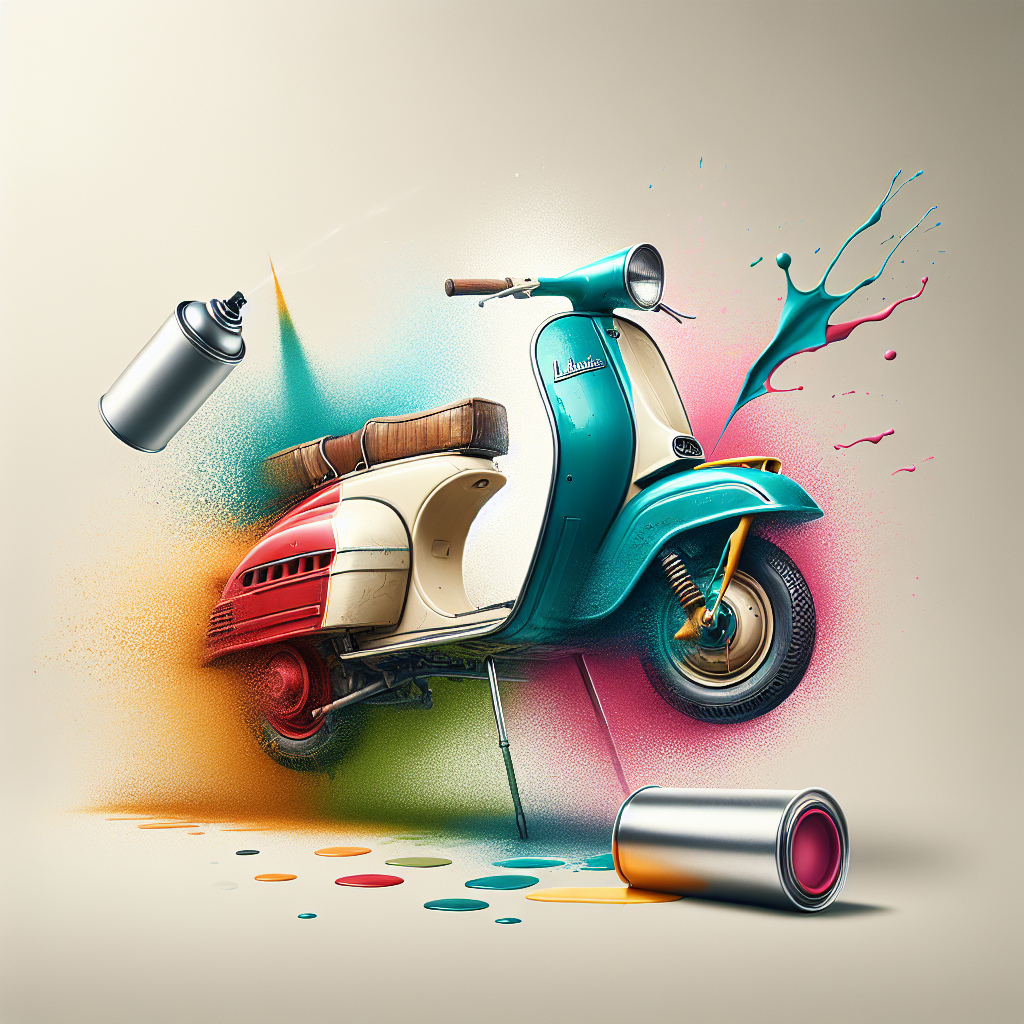
Tools for Accurate Measurement
Accurate measurement of paint quantity is vital to ensure an efficient painting process and avoid unnecessary waste. Having the right tools and following proper measurement techniques will help you achieve precise estimations and prevent over, or under, purchasing of paint.
Tools to Measure Paint Quantity
Several tools can assist in measuring the quantity of paint required for your Lambretta. A paint mixing cup or a graduated cylinder is commonly used to measure liquid paints accurately. These tools provide clear markings or measurements, allowing for precise calculations. Additionally, using a digital scale can be helpful when working with smaller quantities or solid materials such as pigments or flakes. The choice of tool will depend on the specific needs and the consistency of the paint or material being measured.
Tips for Accurate Measurement
To ensure accurate measurement of paint quantity, several tips should be followed. When using a paint mixing cup or graduated cylinder, always ensure it is clean and free from any residue or contaminants that may affect measurement accuracy. If converting measurements between different units, such as milliliters to ounces or grams to pounds, use reliable conversion charts or online calculators for precise results. Measuring paints with transparent or translucent containers against a well-lit background can help in obtaining precise readings. Lastly, remember to consider the specific requirements of the paint system being used, including any dilution ratios or recommendations provided by the manufacturer.
Avoiding Excess or Insufficient Paint
By accurately measuring the required paint quantity, you can avoid the hassle and cost of purchasing excessive amounts or running out of paint mid-project. Having excess paint not only leads to unnecessary waste but also requires storage and disposal considerations. Conversely, insufficient paint can result in inconsistencies in the paintwork or an unfinished appearance. By following proper measuring techniques and carefully estimating the paint quantity required, you can ensure a smooth and efficient painting process.
Dos and Don’ts of Lambretta Spray Painting
Spray painting a Lambretta requires attention to detail, precision, and adherence to best practices. Understanding common painting mistakes to avoid, following pro-tips for a professional finish, and knowing how to maintain your Lambretta’s paint job will help you achieve outstanding results.
Common Painting Mistakes to Avoid
Avoiding common painting mistakes is crucial for achieving a flawless finish. Some common mistakes include inadequate surface preparation, such as insufficient cleaning or improper sanding, which can lead to poor paint adhesion and paint failure. Another mistake is not using the appropriate spraying technique, such as holding the spray gun too close or applying uneven coats. Improper drying times between coats or rushing through the painting process can also result in subpar outcomes. By taking the time to properly prepare the surface, following recommended spraying techniques, and allowing sufficient drying time, you can avoid these mistakes and achieve a professional finish.
Pro-tips for Professional Finish
To achieve a professional finish on your Lambretta, consider the following pro-tips. Firstly, ensure an adequately ventilated and dust-free environment for painting to avoid contaminants settling on the wet paint surface. Secondly, test the paint and clear coat on a small inconspicuous area before applying it to the entire scooter to ensure compatibility and the desired finish. Thirdly, apply thin and even coats of paint, allowing each coat to dry completely before applying the next. This minimizes the risk of runs, drips, or uneven surfaces. Lastly, take your time and be patient. Rushing through the painting process can result in poor outcomes. By following these pro-tips, you can achieve a professional finish that will make your Lambretta stand out.
Maintaining Your Lambretta’s Paint Job
Once your Lambretta’s paint job is complete, proper maintenance is essential to keep it looking fresh and vibrant for years to come. Regular washing with mild soap and water, avoiding harsh chemicals or abrasive cleaners, will help preserve the paint’s integrity. Applying a high-quality automotive wax periodically will add an extra layer of protection and enhance the shine. Additionally, promptly addressing any chips, scratches, or other paint damage can prevent further deterioration. By maintaining a proactive approach to keeping your Lambretta’s paint job in top condition, you can enjoy its beauty and longevity.
In conclusion, understanding the painting process, the influence of your Lambretta’s size, the importance of choosing the right paint, and considering factors like color, primer, clear coat, special effects, and additional layers will greatly contribute to achieving a professional and long-lasting paint job. Accurate measurement of paint quantity using proper tools, adhering to best practices, and avoiding common mistakes will help you achieve outstanding results. By following these comprehensive guidelines, your Lambretta will not only look stunning but also retain its exquisite finish for years to come.
